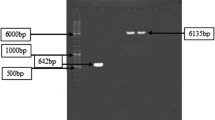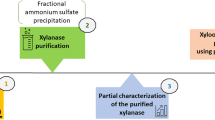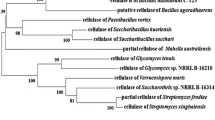Abstract
The alkaliphilic Bacillus halodurans strain PPKS-2 was shown to produce extracellular alkaliphilic, thermostable and halotolerent xylanase. The culture conditions for xylanase production were optimized with respect to pH, temperature, NaCl and inexpensive agro waste as substrates. Xylanase yield was enhanced more than four fold in the presence of 1% corn husk and 0.5% peptone or feather hydrolysate at pH 11 and 37°C. Xylanase was purified to 11.8-fold with 8.7% yield by using traditional chromatographic methods whereas the same enzyme purified to 20-fold with 72% yield by using corn husk as ligand. Its molecular mass was estimated to be 24 kDa by SDS–PAGE. The xylanase had maximal activity at pH 11 and 70°C. The enzyme was active over broad range, 0–20% sodium chloride. The enzyme was thermostable retaining 100% of the original activity at 70°C for 3 h. The apparent K m values for oat spelt xylan and brichwood xylan were 4.1 and 4.4 mg/ml respectively. The deduced internal amino acid sequence of PPKS-2 xylanase resembled the sequence of β-1,4-endoxylanase, which is member of glycoside hydrolase family 11.




Similar content being viewed by others
References
Anuradha P, Vijayalakshmi K, Prasanna ND, Sridevi K (2007) Production and properties of alkaline xylanases from Bacillus sp. isolated from sugarcane fields. Curr Sci 90:1283–1286
Bajpai P (1999) Application of enzymes in the pulp and paper industry. Biotechnol Prog 15:147–157
Battan B, Sharma J, Dhiman SS, Kuhad RC (2007) Enhanced production of cellulase-free thermostable xylanse by Bacillus pumilus ASH and its potential application in paper industry. Enzyme Microb Technol 41:733–739
Beg QK, Bhushan B, Kapoor M, Hoondal GS (2000) Enhanced production of a thermostable xylanase from streptomyces sp, QG-11-3 and its application in biobleaching of eucalyptus kraft pulp. Enzyme Microbiol Technol 27:459–466
Beg QK, Kapoor M, Mahajan L, Hoondal GS (2001) Microbial xylanases and their industrial applications—a review. Appl Microbiol Biotechnol 56:326–338
Cardoso OAV, Filho EXF (2003) Purification and characterization of a novel cellulase-free xylanase from Acrophialophora nainiana. FEMS Microbiol Lett 223:309–314
Collins T, Gerday C, Feller G (2005) Xylanases, xylanase families and extremophilic xylanases. FEMS Microbiol Rev 29:3–23
Dhillon A, Khanna S (2000) Production of a thermostable alkalitolerent xylanase from Bacillus circulans AB 16 grown on wheat straw. World J Microbiol Biotechnol 16:325–327
Gallardo O, Diaz P, Pastor FI (2004) Cloning and characterization of xylanase A from the strain Bacillus sp. BP-7: comparison with alkaline pI-low molecular weight xylanases of family 11. Curr Microbiol 48:276–279
Georis J, Giannotta F, De Buyl E, Granier B, Frere JM, De Buyl E (2000) Purification and properties of three endo-beta-1, 4-xylanases produced by Streptomyces sp. strain S38 which differ in their ability to enhance the bleaching of kraft pulps. Enzyme Microb Technol 26:178–186
Gessesse A, Mamo G (1999) High-level xylanase production by an alkaliphilic Bacillus sp. by using solid-state fermentation. Enzyme Microb Technol 25:68–72
Jalal A, Rashid N, Rasool N, Akhtar M (2009) Gene cloning and characterization of a xylanase from a newly isolated Bacillus subtilis strain R5. J Biosci Bioeng 107:360–365
Khandeparkar R, Bhosle N (2006a) Purification and characterization of thermoalkalophilic xylanase isolated from the Enterobacter sp. MTCC 5112. Res Microbiol 157:315–325
Khandeparkar R, Bhosle N (2006b) Isolation, purification and characterization of the xylanase produced by Arthrobacter sp. MTCC 5214 when grown in solid-state fermentation. Enzyme Microb Technol 39:732–742
Khasin A, Shoham AY (1993) Purification and characterization of a thermostable xylanase from Bacillus stearothermophilus T-6. Appl Environ Microbiol 59:1725–1730
Laemmli UK (1970) Cleavage of structural proteins during assembly of head of bacteriophage. T4. Nature 227:680–685
Lopez-Fernandez CL, Rodriguez J, Ball AS, Copa-Patino JL, Perez-Leblic MI, Arias ME (1998) Application of the affinity binding of xylanases to oat-spelt xylan in the purification of endoxylanase CM-2 from Streptomyces chattanoogensis CECT 3336. Appl Microbiol Biotechnol 50:284–287
Lowry OH, Rosebrough NJ, Farr AL, Randall RJ (1951) Protein measurement with the Folin phenol reagent. J Biol Chem 193(1):265–275
Mamo G, Hatti-kaul R, Mattiasson B (2006) A thermostable alkaline active endo-β1-4-xylanase from Bacillus halodurans S7. Purification and characterization. Enzyme Microb Technol 39:1492–1498
Miller G (1959) Use of dinitrosalicylic acid reagent for determination of reducing sugars. Anal Chem 31:426–428
Nakamura S, Wakabayashi K, Nakai R, Ano R, Horikoshi K (1993) Purification and some properties of an alkaline xylanase from alkaliphilic Bacillus sp. strain 41M-1. Appl Environ Microbiol 59:2311–2316
Nath D, Rao M (2000) pH dependent conformational and structural changes of xylanase from an alkalophilic thermophilic Bacillus sp. (NCIM59). Enzyme Microb Technol 28:397–403
Palonen H, Tenkanen M, Linder M (1999) Dynamic interaction of Trichoderma reesei cellobiohydrolases Cel6A and Cel7A and cellulose at equilibrium and during hydrolysis. Appl Environ Microbiol 65:5229–5233
Perkins DN, Pappian DJ, Creasy DM, Cottrell JS (1999) Probability-based protein identification by searching sequences database using mass spectroscopy data. Electrophoresis 20:3551–3567
Prakash P, Jayalakshmi SK, Sreeramulu K (2010) Production of keratinase by free and immobilized cells of Bacillus halodurans strain PPKS-2 partial characterization and its application in feather degradation and dehairing of the goat skin. Appl Biochem Biotechnol 160:1909–1920
Qureshy AF, Khan LA, Khanna S (2000) Expression of Bacillus circulans Teri-42 xylanase gene in Bacillus subtilis. Enzyme Microb Technol 27:227–233
Rani DS, Nand K (2000) Production of thermostable cellulase-free xylanase by Clostridium absonum CFR-702. Process Biochem 36:255–262
Ratanakhanokchai K, Kyu KL, Tanticharoen M (1999) Purification and properties of a xylan-binding endoxylanase from alkaliphilic Bacillus sp. Strain K-1. Appl Environ Microbiol 65:694–697
Saha CB (2003) Hemicellulosic bioconversion. J Ind Microbiol Biotechnol 30:279–291
Sanghi A, Garg N, Kuhar K, Kuhad RC, Gupta VK (2009) Enhanced production of cellulase-free xylanase by alkalophilic Bacillus subtilis ASH and its application in biobleaching of kraft pulp. Bio Resources 4:1109–1129
Santos ESD, Guirardello R, Franco TT (2002) Preparative chromatography of xylanase using expanded bed adsorption. J Chromatogr 944:217–224
Silveira FQP, Melo IS, Filho EXF (1997) Carbohydrate-hydrolysing enzyme activity production by solid-state cultures of Trichoderma harzianum strains. Rev Microbiol 28:152–156
Singh S, Madlala AM, Prior BA (2003) Thermomyces lanuginosus: properties of strains and their hemicellulases. FEMS Microbiol Rev 27:3–16
Subramaniyan S, Prema P (2000) Cellulase free xylanases from Bacillus and other microorganisms. FEMS Microbiol Lett 183:1–7
Subramaniyan S, Sandhia GS, Prema P (2001) Control of xylanase production without protease activity in Bacillus sp. by selection of nitrogen source. Biotechnol Lett 23:369–371
Sun Y, Cheng J (2002) Hydrolysis of lignocellulose materials for ethanol production. A review. Biores Technol 83:1–11
Tabernero C, Sanchez-Torres J, Perez P, Santamaria RI (1995) Cloning and DNA sequencing of xyaA, a gene encoding an endo-beta-1,4-xylanase from an alkalophilic Bacillus strain (N137). Appl Environ Microbiol 61:2420–2424
Techaapiakoon C, Kyu KL, Ratanakhnokchai K (2006) Purification of xylanase from alkaliphilic Bacillus sp. K-8 by using corn husk column. Process Biochem 41:2441–2445
Techapun C, Sinsuwongwat S, Poosaran N, Watanabe M, Sasaki K (2001) Production of a cellulase-free xylanase from agricultural waste materials by a thermotolerant Streptomyces sp. Biotechnol Lett 23:1685–1689
Teotia S, Khare SK, Gupta MN (2001) An efficient purification process for sweet potato beta-amylase by affinity precipitation with alginate. Enzyme Microb Technol 28:792–795
Vafiadi C, Christakopoulos P, Topakas E (2010) Purification, characterization and mass spectrometric identification of two thermophilic xylanases from Sporotrichum thermophile. Process Biochem 45:419–424
Viikari L, Kantelinen A, Sundquist J, Linko M (1994) Xylanases in bleaching: from an idea to the industry. FEMS Microbiol Rev 13:335–350
Wang CY, Chan H, Lin HTY, Shyu YT (2010) Production, purification and characterisation of a novel halostable xylanase from Bacillus sp. NTU-06. Ann Appl Biol 156:187–197
Wejse PL, Ingvorsen K, Mortensen KK (2003) Xylanase production by a novel halophilic bacterium increased 20-fold by response surface methodology. Enzyme Microb Technol 32:721–727
Wu S, Liu B, Zhang X (2006) Characterization of a recombinant thermostable xylanase from deep-sea thermophilic Geobacillus sp. MT-1 in East Pacific. Appl Microbiol Biotechnol 72:1210–1216
Xia L, Len P (1999) Cellulose production by solid-state fermentation on lignocellulosic waste from the xylose industry. Process Biochem 34:909–912
Acknowledgments
This research was supported by a grant to K.S. from the University Grants Commission and UGC-SAP (DRS-I), New Delhi.
Author information
Authors and Affiliations
Corresponding author
Rights and permissions
About this article
Cite this article
Prakash, P., Jayalakshmi, S.K., Prakash, B. et al. Production of alkaliphilic, halotolerent, thermostable cellulase free xylanase by Bacillus halodurans PPKS-2 using agro waste: single step purification and characterization. World J Microbiol Biotechnol 28, 183–192 (2012). https://doi.org/10.1007/s11274-011-0807-2
Received:
Accepted:
Published:
Issue Date:
DOI: https://doi.org/10.1007/s11274-011-0807-2




